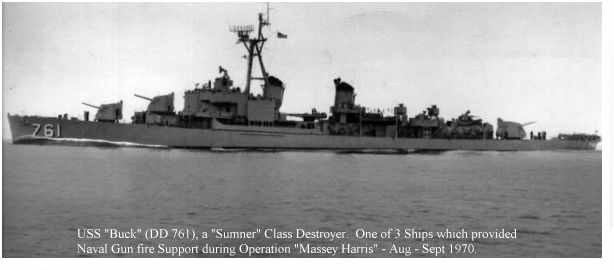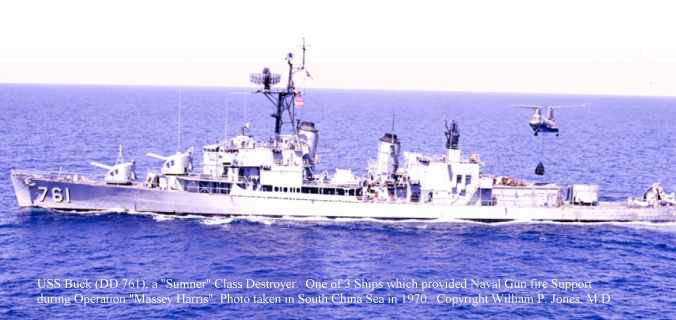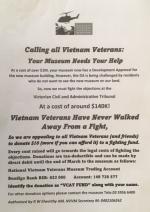
Technical Details of USS Buck, DD 761, a "Sumner" Class Destroyer
- Builder: Bethlehem Steel, San Francisco.
- Laid Down: 01 February, 1944
- Launched: 11 March, 1945
- Commissioned: 28 June, 1946
- Decommissioned, America: 15 July 1973 (stricken)
- Fate: To Brazil, 16 July, 1973. Renamed "Alagoas".
- Decommissioned, Brazil: 30 June 1995.

On 10 November Commander Dale W. Duncan, USN, relieved Commander Paul J. Mode and took over as Commanding Officer.
From: Commanding Officer, USS BUCK (DD-761), J.E. Blasko, by direction.
To: Chief of Naval Operations
The USS BUCK DD-761, christened over 25 years ago, proved again this year that she is a valuable asset to the defence posture of the United States. Performing admirably during the first half of 1970, constantly practicing her techniques and having her talents home in the Southern California operating areas, she was to show her true mettle during the last half of the year in Western Pacific waters. 1970 proved to be nothing more than one more year in a 25 year old tradition of excellence.
The first of the year found the BUCK completing a well deserved holiday leave period on San Diego. It was during this leave period that word came in for the ship to undergo a one month yard period at Long Beach Naval Shipyard for the purpose of replacing the sonar dome. By January, all work had been completed and the BUCK was once again under way; this time the destination was Wilson Cove, San Clemente Island, for FORACS calibration.
During February the BUCK commenced the formal triennial INSURV Inspection; an inspection designed to determine the suitability of the ship for future active service. When the results were in, it was determined that the ship was in remarkably good condition and most certainly fit for at least one more year of service. March through July found the ship in shore bombardment, ASW, COMCRUDESPAC PMS Inspection and an inspection by Captain Guy M. Neely, COMDESDIV 72, which was to determine the administrative, material, and personnel readiness of the BUCK. The ship scored a grade of 94.9. a tenth of a point from a grade of "Outstanding".
On 27 July the ship was under way for the West Pacific. The ship's chronology reveals the following:
- 1 Aug. MRD Pearl Harbour
- 10 Aug. Fuel and water Midway Island
- 14 Aug. U/W INCHOP SEVENTHFLT, (Seventh Fleet)
- 17 Aug. Transit Guam to Subic Bay
- 24 Aug. Gunline, III M.R.
- 26 Aug. Support for Operation "Massie Harris" N. of Vung Tau
- 10 Sept. Subic Bay
- 2 Oct. Destination South SAR Station. Tonkin Gulf
- 28 Oct. Enroute to Bangkok
The fifteenth and final Western Pacific deployment for the USS BUCK was one of her finest. Highlighting the cruise were the three Naval gunfire support missions during which the ship fired over 5000 rounds of 5"/38 calibre projectiles. She distinguished herself by accounting for forty-one bunkers destroyed and twenty eight damaged, twenty-six secondary explosions, seven structures destroyed and eight damaged, ten fighting holes destroyed and five damaged,600 meters of trenches interdicted with 185 meters of trench destroyed, as well as four known KIA's. She also fired many unobserved missions where gun damage could not be determined. So the record stands, the BUCK, commanded by Commander Dale W. Duncan, has met the challenges of 1970. Her last cruise, it may justifiably be said that the USS BUCK is now a proud tradition in the hearts and minds of all destroyer men.
MISCELLANEOUS STATISTICS
1 JANUARY TO 31 DECEMBER 1970 MILES TRAVELED 23,621
AMMO EXPENDITURES 5,263
DASH HOURS 31.3
DASH FLIGHTS 28
NSFO CONSUMED 2,030,294 GALLONS
PERSONNEL CASUALTIES MAJOR 3
MINOR 29
HEAT 8
LESSONS LEARNED
Probably the two most important items realised from the past year by the members of the USS BUCK were the vitally important use of the destroyers in today's Navy, and second, the utter necessity of training at all levels. Without destroyers, the carriers could not operate as they do now and naval gunfire support would, for the most part be non-existent. On the other hand, without the training that the BUCK went through day after day, these final ends could never have resulted. Quick and proper response became BUCK's bywords through the continued training of all hands.


